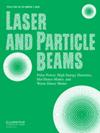用Langmuir探针表征激光烧蚀Zr等离子体的电子温度和电子密度及其与表面修饰的关系
IF 1.9
4区 物理与天体物理
Q4 PHYSICS, APPLIED
引用次数: 1
摘要
利用Langmuir探针技术,利用调q Nd:YAG激光器(532 nm, 6 ns)在8.6 ~ 15.5 GW/ cm2的辐照度范围内研究了激光烧蚀锆(Zr)的等离子体参数。所有的测量都是在超高真空条件下进行的,同时探头与目标保持4毫米的固定距离。通过改变1 ~ 75v的偏置电压,示波器上的探头测量相应的电流值。利用Langmuir探针数据的I-V特性曲线,对激光诱导Zr等离子体的电子温度、电子数密度、等离子体势、德拜长度和热速度等参数进行了评价。结果表明,随着激光辐照强度的增加,Zr等离子体的电子温度和热速度分别从18 ~ 41 eV和2.8 × 10 8 ~ 4.3 × 10 8 cm/s呈上升趋势,这是由于能量沉积和烧蚀速率的增加。辐照度从8.6 GW/cm 2增加到10.9 GW/cm 2时,Zr等离子体的电子数密度从6.5 × 10 14增加到6.7 × 10 14 cm−3,但没有明显的增加。辐照度从12 GW/cm 2进一步增加到15.5 GW/cm 2,导致Zr等离子体的密度从6.1 × 10 14降低到5.6 × 10 14 cm−3,这是由于形成了厚鞘层、双极电场和激光支持的爆震波(激波锋)。扫描电镜分析了辐照Zr的表面形貌。它揭示了裂缝、脊、锥和颗粒的形成。在高辐照度下观察到脊状结构消失,而锥状结构和裂纹是主要特征。通过控制等离子体参数,可以控制材料的表面结构,在工业和医学上有着广泛的应用。本文章由计算机程序翻译,如有差异,请以英文原文为准。
Evaluation of electron temperature and electron density of laser-ablated Zr plasma by Langmuir probe characterization and its correlation with surface modifications
The plasma parameters of laser-ablated Zirconium (Zr) using a Langmuir probe technique have been investigated by employing a Q-switched Nd:YAG laser (532 nm, 6 ns) at various irradiances ranging from 8.6 to 15.5 GW/cm 2 . All the measurements have been performed under an ultra-high vacuum condition while keeping the probe at a fixed distance of 4 mm from the target. By varying the biasing voltages from 1 to 75 V, the corresponding values of electric currents are measured by the probe on the oscilloscope. Laser-induced Zr plasma parameters such as electron temperature, electron number density, plasma potential, Debye length, and thermal velocity have been evaluated from I–V characteristic curves of Langmuir probe data. It is found that both the electron temperature and thermal velocity of Zr plasma reveal an increasing trend from 18 to 41 eV and 2.8 × 10 8 to 4.3 × 10 8 cm/s, respectively, with increasing laser irradiance which is attributed to more energy deposition and enhanced ablation rate. However, the electron number density of Zr plasma exhibits a non-significant increase from 6.5 × 10 14 to 6.7 × 10 14 cm −3 with increasing irradiance from 8.6 to 10.9 GW/cm 2 . A further increase in irradiance from 12 to 15.5 GW/cm 2 causes a reduction in the number density of Zr plasma from 6.1 × 10 14 to 5.6 × 10 14 cm −3 which is attributed to the formation of thick sheath, ambipolar electric field, and laser-supported detonation waves (Shock front). Scanning electron microscope analysis has been performed to reveal the surface morphology of irradiated Zr. It reveals the formation of cracks, ridges, cones, and grains. It was observed at high irradiances the ridges are vanished, whereas cones and cracks are dominant features. By controlling plasma parameters, surface structuring of materials can be controlled, which has a vast range of applications in the industry and medicine.
求助全文
通过发布文献求助,成功后即可免费获取论文全文。
去求助
来源期刊

Laser and Particle Beams
PHYSICS, APPLIED-
CiteScore
1.90
自引率
11.10%
发文量
25
审稿时长
1 months
期刊介绍:
Laser and Particle Beams is an international journal which deals with basic physics issues of intense laser and particle beams, and the interaction of these beams with matter. Research on pulse power technology associated with beam generation is also of strong interest. Subjects covered include the physics of high energy densities; non-LTE phenomena; hot dense matter and related atomic, plasma and hydrodynamic physics and astrophysics; intense sources of coherent radiation; high current particle accelerators; beam-wave interaction; and pulsed power technology.
 求助内容:
求助内容: 应助结果提醒方式:
应助结果提醒方式:


